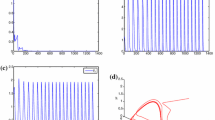Abstract
Based on integrated pest management, a stage-structured predator-prey system with Holling type-II functional response concerning impulsive control strategy is investigated. By the Floquet theory and small amplitude perturbation skills, it is proved that there exists a globally stable pest-eradication periodic solution when the impulsive period is less than some critical values. Further, sufficient conditions for the permanence of the system is established. Numerical simulations are carried out to illustrate the effect of impulses on the dynamics of the system.
Similar content being viewed by others
References
Barclay H.J.: Models for pest control using predator release, habitat management and pesticide release in combination. J. Appl. Ecol. 19, 337–348 (1982)
Caltagirone L.E., Doutt R.L.: Global behavior of an SEIRS epidemic model with delays, the history of the vedalia beetle important to California and its impact on the development of biological control. Ann. Rev. Entomol. 34, 1–16 (1989)
Freedman H.J.: Graphical stability, enrichment, and pest control by a natural enemy. Math. Biosci. 31, 207–225 (1976)
Liu B., Chen L., Zhang Y.: The dynamics of a prey-dependent consumption model concerning impulsive control stratery. Appl. Math. Comp. 169, 305–320 (2005)
Van Lenteren J.C.: Measures of success in biological control of anthropoids by augmentation of natural enemies. In: Wratten, S., Gurr, G. (eds) Measures of success in biological control, Kluwer Academic Publishers, Dordrcht (2000)
Wang W. et al.: Global dynamics of a population model with stage structure for predator. In: Chen, L. (ed.) Advanced topics in Biomathematics, pp. 253–257. Word Scientific Publishing Co. Pte. Ltd., Singapore (1997)
Xiao Y., Chen L.: Global stability of a predator-prey system with stage structure for the predator. Acta Math. Sinica 19, 1–11 (2003)
Xu R., Ma Z.: The effect of stage-structure on the permanence of a predator-prey system with time delay. Appl. Math. Comput. 189, 1164–1177 (2007)
Author information
Authors and Affiliations
Corresponding author
Rights and permissions
About this article
Cite this article
Wang, L., Xu, R. & Feng, G. Analysis of a Stage-Structured Predator-Prey System Concerning Impulsive Control Strategy. Differ Equ Dyn Syst 19, 303–313 (2011). https://doi.org/10.1007/s12591-011-0092-4
Published:
Issue Date:
DOI: https://doi.org/10.1007/s12591-011-0092-4




